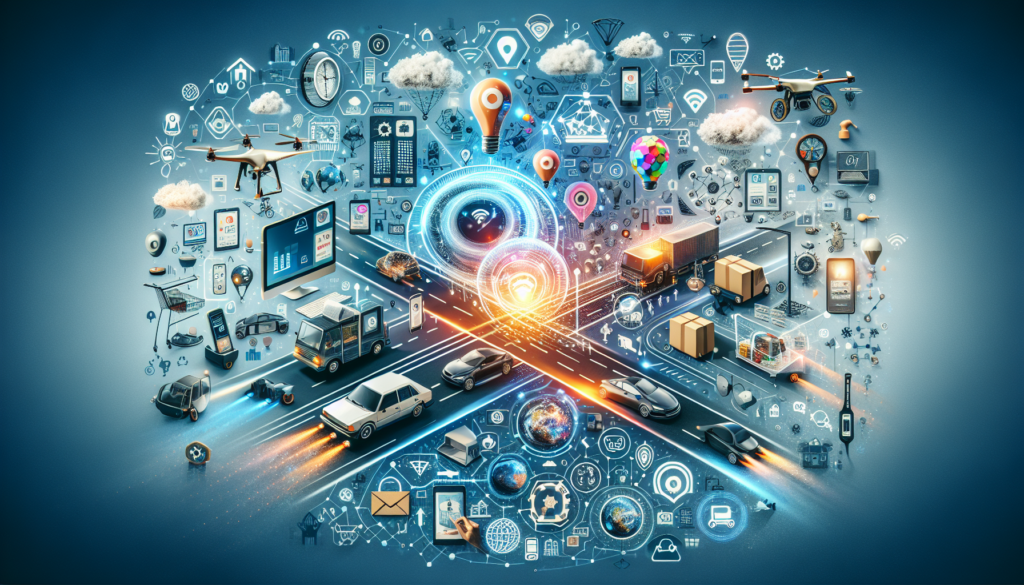The Internet of Things (IoT) is reshaping e-commerce at a dizzying pace, changing the way businesses interact with consumers and enhancing operational efficiency. These advances are driven by a convergence of emerging technologies and the proliferation of connected devices, leading to innovations that previously seemed like distant milestones of a technological future. The ability to capture and analyze data in real time has opened the horizon to an unprecedented level of customer service personalization and supply chain optimization.
Practical Applications of IoT in E-Commerce
Supply Chain Optimization
IoT provides the capability to track products from the manufacturer to the end consumer. Smart sensors and RFID devices enable exhaustive and real-time tracking, optimizing logistics and reducing delivery times. A notable example is the use of smart tags in shipping containers, which not only transmit location but also environmental conditions, such as temperature or humidity, crucial for sensitive products like pharmaceuticals or food.
Personalized User Experience
Personalized recommendations based on data collected by IoT devices, such as wearables and voice assistants, are transforming the online shopping experience. These devices capture user preferences and behavioral patterns, allowing e-commerce platforms to offer a tailored shopping experience and anticipate consumer needs.
Inventory and Warehouse Management
Inventory management systems integrated with IoT provide unprecedented real-time visibility into stock, improving inventory accuracy and preventing overstock or shortages. For example, in smart warehouses, drones equipped with RFID scanners can autonomously conduct inventories, and automated guided vehicles (AGVs) are responsible for moving products, which streamlines the reception, storage, and dispatch of goods.
Efficient Returns Handling
Returns are a significant issue in e-commerce. IoT facilitates the traceability of returned products and their efficient reintegration into inventory. Connected devices can streamline the inspection process and reassignment of returned items, reducing costs and improving returns management.
Technical Advances in IoT Applied to E-Commerce
Use of Big Data and Predictive Analytics
Machine learning algorithms and predictive analytics work alongside IoT to process large volumes of data and discern purchase patterns, predict market demands, and automatically adjust inventory levels. This interrelationship between IoT and Big Data is fundamental for a proactive rather than reactive business strategy.
Advanced Connectivity Networks
The rollout of 5G networks promises to further accelerate the implementation of IoT in e-commerce, thanks to its low latency and high data speeds, which will allow for more fluid and dynamic interaction between devices and online management systems.
Robust Cybersecurity
As the number of connected devices increases, so does the attack surface for potential security breaches. Investments in cybersecurity focused on IoT ensure the protection of sensitive consumer data and the integrity of e-commerce systems.
Case Studies and Comparison with Previous Works
A significant case study is observed in the collaboration between Amazon and its Dash replenishment system. Dash buttons act as IoT devices that allow users to quickly reorder consumable items. Compared to traditional e-commerce, where replenishment depended on the user’s manual intervention, Dash represents the evolution towards autonomous management of domestic inventory, facilitated by IoT.
Another example is the use of smart mirrors in clothing stores, which allow customers to see how a garment fits without having to try it on. These mirrors, being connected, collect customer preference data, which can be used for trend analysis and predictive stocking. Compared to old market research methods, smart mirrors offer a more direct data collection applicable to marketing strategies and inventory management.
Future Directions and Potential Innovations
The integration of Artificial Intelligence with IoT will continue to advance the self-improvement capability of e-commerce systems. An evolution toward even more intuitive platforms is expected, capable of automatically adjusting to market fluctuations and offering an even more sophisticated level of customer personalization.
In summary, the transformation of e-commerce by IoT is an unstoppable trend that is dictating a new paradigm of commercial interaction. Constant innovation in the field demands a commitment to security, consumer privacy, and sustainability. Businesses that successfully incorporate IoT into their commercial strategies not only benefit from increased operational efficiency but also significantly improve customer satisfaction. As technology continues to evolve, it’s vital for e-commerce players to stay updated and adapt quickly to maintain their competitiveness in an increasingly interconnected market.

